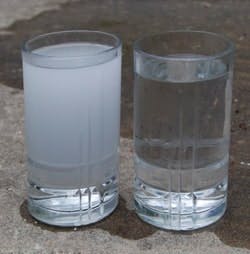Many public water supplies have entrained air that causes the water to appear milky or cloudy. Conventionally, stilling basins are used to treat for entrained air and gases by reducing flow velocity while providing detention. This process can require re-pumping. Stilling basins also add significantly to a plant’s footprint and require additional construction.
A Treatment Alternative
United Water New York (UWNY) owns and operates the water supply, treatment and distribution system that serves most of Rockland County, N.Y., including 45 wells located throughout the county. Some of the wells contain high levels of entrained or dissolved air and must be operated below capacity.
Hydrophobic membranes have been used successfully in the beverage and semi-conductor industries for the removal of entrained gases. To determine whether this technology was suitable for use in municipal drinking water, UWNY pilot-tested a Membrana Liqui-Cel Contactor to remove dissolved air from several wells.
Following the successful pilot test, UWNY contracted with Layne Christensen Co. , which assisted in the design and then constructed two de-aeration systems for two well locations: New Hempstead and Willow Tree. The challenge was to optimize the use of these wells while minimizing capital and operating expenses. The New Hempstead treatment facility serves Wells 18 and 24, and is designed to operate at a combined permit capacity flow of 1,700 gal per minute (gpm).
The Willow Tree treatment facility serves Well 56 and is designed to operate at a permitted well capacity maximum flow of 1,000 gpm. Pump capacity is 850 gpm.
Results
Two full-scale facilities have been constructed and are providing reduced CapEx and OpEx compared to typical technologies used for dissolved air removal.
The facilities provide a number of benefits for UWNY, including the following:
- Cost for a stilling basin/booster pumping facility for New Hempstead was estimated at $3.3 million. The de-aeration alternative provided a significant savings in construction costs, and provides ongoing benefits since the wells can now operate at their full design and permit capacity.
- Smaller footprint and above-ground construction helps to streamline the permitting process and construction schedule. Well water can be pumped to the membranes and into distribution without breaking head. Head loss through the membranes is less than 5 psi, so the existing pumps experience minimal reduction in pumping rate. New pumps can be installed to maintain the design pumping rate. The membrane requires about half the footprint as the stilling basin and can be installed on a concrete slab on grade, eliminating the need for construction of a larger underground structure.
Membrane technology has been proven technically feasible and cost-effective for removal of entrained or dissolved air from selected wells. The same technology also is effective for the removal of other dissolved gases and volatile substances in municipal water supplies, such as carbon dioxide, radon, THM and other VOCs, providing an effective alternative to aerators, packed column air stripping towers and other treatment methods.
John Dyksen is with United Water and J. Savino is with Layne Christensen Co. For more information, contact Lisa Culbert, marketing manager, Layne Christensen Co., at [email protected] or 602


